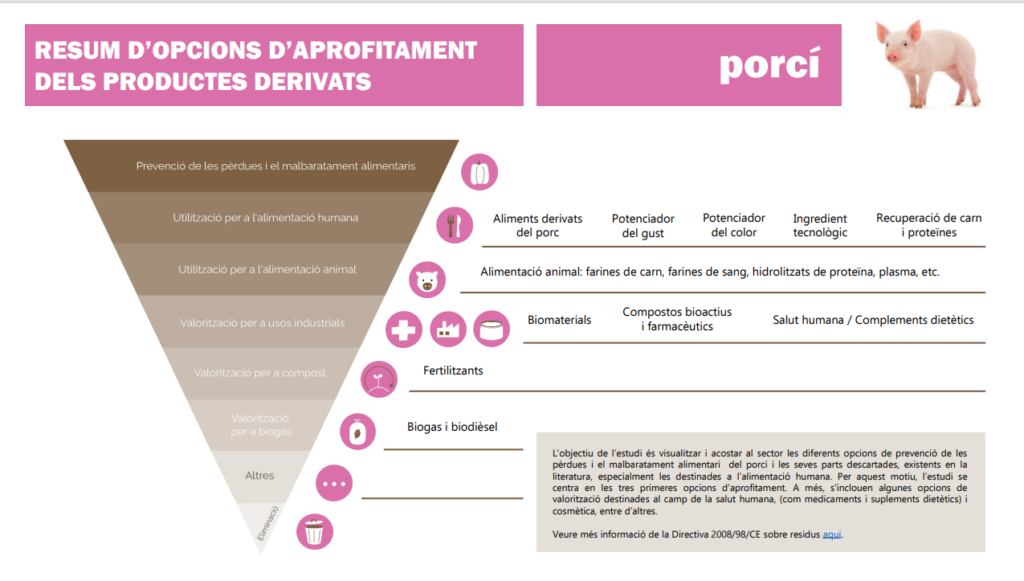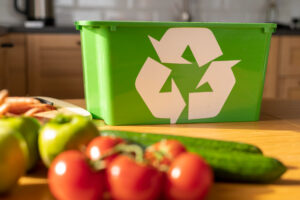Pork has good nutritional quality, is rich in vitamins, minerals and proteins and is the second most consumed meat in the world, after poultry, according to data from the Generalitat de Catalunya. According to projections by the Organization for Economic Co-operation and Development (OECD), meat production and consumption is expected to continue to increase globally in the coming years to meet the protein demand of a growing and more empowered population. acquisitive Consequently, the amount of discarded food derived from this product will also increase.
Algunes dades significatives del sector porcí a Catalunya:
- Some significant data from the pig sector in Catalonia The Catalan pig sector accounts for 62% of livestock production.
- 68.07% of farms have the pig sector as their main activity, with a total of 5,444 pig farms and 7,840,519 heads.
- Lleida is the main Catalan region producing fattening pigs (2022 agricultural census).
The potential for using products derived from pigs for human consumption is very high. The carcass is composed of muscle, fat (intermuscular and subcutaneous), bone and skin, and approximately 61% of the carcass weight is meat.
What can be used from pork and what is it for?


What do we take advantage of?
Derived foods:
Les vísceres, la sang, els ossos, la pell i el greix es poden aprofitar per a l’elaboració d’aliments i
són una bona font de proteïna i vitamines. El consum d’aquestes parts forma part de la nostra
cultura culinària; tanmateix, avui dia no són tan apreciades com abans.
Flavor enhancer:
El greix de porc té un gust molt distintiu i una estructura cristal·lina única que millora la textura de
pasta de full i altres tipus de masses. Té un punt de sabor fumat i no es fon a temperatura
ambient, cosa que el fa molt adient en aplicacions culinàries.
Color enhancer:
Color enhancers improve and homogenize the color of meat products and are usually
obtained from blood.
Technological ingredient:
― Blood plasma has the ability to form gel as it contains 60% albumin. This gel has a protein concentration of 4-5% and is used in the processing of meat products, specifically cooked hams and frankfurters. In fact, it has been seen that for cooked ham the addition of
1.5 to 3% and for frankfurters the addition of 2.7% of frozen blood plasma generate
more satisfactory colors respect to those that do not contain it. In addition, thanks to its foaming ability,
it can also be used for example as an egg substitute in bakery products (egg allergy
is one of the main al· food allergies according to AESAN).
― Gelatin and collagen. Gelatin is a gelling agent and collagen is used as an
emulsifier, foaming agent, colloid stabilizer, etc.
― Protein hydrolysates. They are used to stabilize formulations. They provide protein and flavor.
Recovery of meats and proteins:
Different protein extraction processes can be applied to recover proteins from viscera or meat cuts of low economic value.
Bioactive and pharmaceutical compounds:
― Pig waste products are a source of bioactive compounds ranging from peptides to other
biomolecules that have a physiological benefit.
― Protein-rich parts are a very good source of bioactive peptides. The types of benefits
reported are: antioxidant, antimicrobial, antihypertensive, antidiabetic, etc. However, there are many
limitations that hinder their commercialization such as economic viability or bioavailability.
― Other compounds of medical interest can be obtained from co-products such as insulin, heparin
and other hormones or collagen; this, apart from its application in the food industry
also has outstanding applications in biomedicine.
― This can be an opportunity to recover high-value ingredients to increase the economic
performance of the meat industry and also improve consumer health.
Animal feed
― The discarded parts of the pig are undoubtedly a very interesting way of valorizing
co-products due to their reintroduction into the food chain.
― Bones: they can be used for animal nutrition as a source of protein due to their content in
essential amino acids, minerals and vitamin B12.
― Viscera: used in poultry, fish or pet food. Meat
and/or bone meal can be made from viscera and digestive tissue, bones, blood, lean tissue and fat.
― Blood: porcine blood derivatives can be used for non-ruminant animals, aquaculture and companion animals. You can make blood meal (in fish feed for example) or plasma
which, as an ingredient for animal feed, represents a protein of high quality and
digestibility.
― The hydrolysates of pig mucosa are products of interest in feeding piglets due to their high palatability and digestibility of the amino acids it contains.
Other non-food uses
― El potencial d’aprofitament de productes derivats del porc per a l’alimentació humana és molt elevat i és la via a la qual s’ha de donar prioritat atès que són una molt bona font de proteïna, minerals i vitamines. Tanmateix, com ja s’ha descrit en aquesta fitxa, hi ha altres vies de valorització com ara l’elaboració d’ingredients per a la indústria alimentària i l’extracció de compostos bioactius per a la seva utilització en nutricèutica i farmàcia.
― Quan aquestes vies de valorització no són possibles, també es poden plantejar usos de valorització energètica i elaboració de fertilitzants que són usos molt comuns.
― Altres vies d’aprofitament més innovadores són l’elaboració de biomaterials o elaboració de bioestimulants per millorar els rendiments agrícoles.
― Tot i que es tracta de vies no prioritàries en el marc d’aquest estudi, són alternatives que tenen el potencial de contribuir a la reducció de residus i a la millora del rendiment econòmic del sector.










 The food waste plan should not include the weight of the packaging. Therefore, it is necessary to remove the packaging from all packaged products before quantifying them or calculating their weight and subtracting it from the total weight, either directly or approximately.
The food waste plan should not include the weight of the packaging. Therefore, it is necessary to remove the packaging from all packaged products before quantifying them or calculating their weight and subtracting it from the total weight, either directly or approximately.